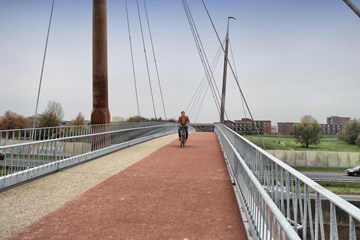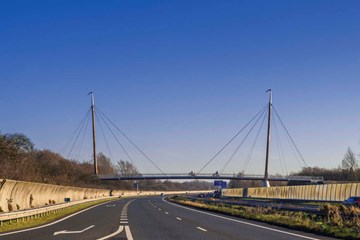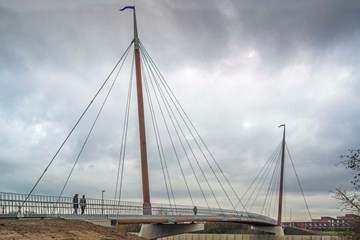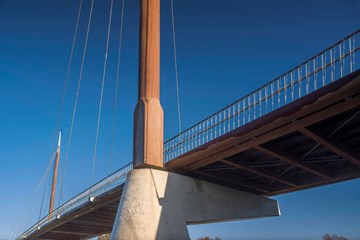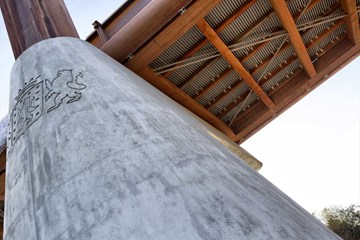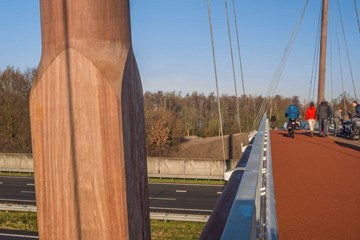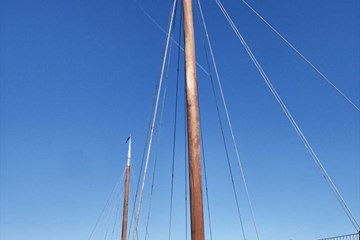Botterbrug, Harderwijk
Over de snelweg, langs het meer
Om vanuit de zuidelijk gelegen wijk Drielanden via de wijk Stadsweiden naar het centrum van Harderwijk te fietsen moet de snelweg A28 worden overgestoken. De gemeente Harderwijk wilde een fietsbrug die langs de rand van het Crescentpark de oversteek maakt. Via een landelijk gebied kom je dan op het fietspad langs het Veluwemeer dat je naar het hart van de stad voert. Bij de opdracht werd bepaald dat het ontwerp van de fietsbrug zou moeten verwijzen naar de traditionele platbodem zeilschepen die de vissershaven van Harderwijk kenmerken. Het moest een botterbrug worden.
Een Harderwijkse brug
Het bouwbedrijf Heijmans, het architectenbureau ZJA en de houtfirma Wijma Kampen realiseerden een ontwerp dat als een echte toegangspoort tot de stad Harderwijk kan gelden, en zowel voor de fietsers als voor de passerende automobilisten op de A28 en memorabele blikvanger is.
Voor de oversteek zijn in feite niet één maar drie bruggen nodig. Na de grote sprong over de snelweg ligt er in het verlengde daarvan een even lange brug op pijlers met steeds een kleine 8 meter overspanning. Daarmee wordt het fietspad over een kruisend fietspad geleid. Vervolgens is er nog een kleine brug die 10 meter over een beekdal overbrugt. De eerste twee bruggen zijn grotendeels van hout, de kleine brug is van plaatstaal.
Twee botters
Het ontwerp heeft het thema van de aanblik van een haven vol botters vertaald naar een hedendaagse, functionele en duurzame fietsbrug. De houten dekken zijn geïnspireerd op de structuur van hardhouten sluisdeuren, die zijn gevat in een stalen raamwerk. De brug over de snelweg is een 76 meter lange tuibrug met twee pijlers. Dat zijn massieve pylonen van azobé, -een houtsoort die veel gebruikt wordt in de waterbouw en de scheepsbouw-, gevat in een betonnen voetstuk. Wie over de brug fietst voelt zich even omringd door twee aangemeerde botters. In het silhouet valt de hoek op waaronder de pylonen staan. Het herkenbare asymmetrische beeld van een botter en de beweging die zeilschepen eigen is, worden in herinnering geroepen. Bovendien verbeeldt het ontwerp de krachten die in het spel zijn bij een brug met 50 meter overspanning. De masten en de kabels aan weerszijden van de brug geven bij het passeren een intrigerende visuele beleving. Op de top van de pylonen zijn gestileerde vlaggen geplaatst die de verwijzing naar de botters compleet maken.
Duurzaam en herbruikbaar
De 21meter hoge azobé-houten pylonen zijn afkomstig uit de tropische bossen die de firma Wijma zelf beheert, om zorg te dragen voor werkelijk duurzaam geoogst hout. In 2015 werd dit project bekroond met de Nederlandse FSC Award, om de inspiratie die het biedt voor het herbruikbaar toepassen van duurzaam hout. Het hout is onbehandeld gebruikt juist omdat het met de invloed van weer en wind en onvermijdelijke beschadigingen aan schoonheid en karakter zal winnen. De kleuren ervan contrasteren mooi met de lichtere roestvrijstalen balustraden. De toepassing van deze houtsoort heeft naast historische en esthetische redenen ook een heel functionele, het bespaart onderhoud.
Het stadswapen van Harderwijk staat in reliëf in de betonnen voetstukken van de pylonen. De brug werkt inderdaad als een herkenbare toegangspoort voor de stad en vervult die functie op een functionele en hedendaagse manier, met gebruikmaking van karakteristieke materialen en met oog voor landschap en lokale geschiedenis.
Architect: ZJA
Klant: The municipality of Harderwijk
Opdrachtgever: Heijmans
[English]
Across the motorway, along the lake
When cycling from the Drielanden neighbourhood, via Stadsweiden to the centre of Harderwijk, one must cross the A28 motorway. The city council of Harderwijk commissioned a bicycle bridge to cross the motorway, located along the border of the Crescentpark. Riding through the countryside, cyclists reach the bicycle path along the banks of the Veluwe Lake that leads them into the town centre. The design requirements of the bicycle bridge stated it had to contain recognizable references to the traditional flat-bottomed sailing ships – called “botters” – that the fishing port of Harderwijk is famous for.
A typical Harderwijk bridge
Together, the Heijmans construction company, architectural studio ZJA and timber company Wijma Kampen created a design that can serve as a true gateway to the city of Harderwijk. It works as a memorable eye-catcher for both crossing cyclists and motorists on the A28 below.
The entire crossing actually requires not one, but three bridges. After making the leap across the motorway, a second equally long bridge is built in line with the first. This second bridge rests on pylons almost 8 meters apart, carrying the cyclists over a bicycle path below. Then, a small bridge with a 10 meters span is needed to cross a creek. The first two bridges are constructed in wood and the small bridge is made of steel.
Two traditional flat-bottomed ships
The design translates the theme of a port full of traditional flat-bottomed ships into a contemporary, functional and sustainable bicycle bridge. The wooden decks are inspired by the structure of hardwood lock doors, contained in a steel grid. The bridge across the motorway is a 76-meter-long cable bridge resting on two pylons. These are made of massive azobé hardwood – a type of wood used in hydro-engineering and shipbuilding – mounted on a concrete base. For a brief moment, cycling across the bridge gives the impression of being among two moored traditional flat-bottomed ships . The silhouette shows the remarkable tilt of the pylons. It refers to the recognizable asymmetric rigging of a smack and to the natural movement of moored sailing ships. The design also draws attention to the forces at play in a cable bridge spanning 50 meters. In passing, the masts and cables on either side of the bridge provide an intriguing visual experience. On top of the pylons stylized flags complete the reference to the smack fleet of Harderwijk.
Sustainable and recyclable
The 21-meter-long pylons out of azobé hardwood originate from the tropical forests managed and stewarded by the Wijma company itself, to ensure the wood is forested in a truly sustainable manner. In 2015 this project received the Dutch FSC Award for how it introduces and inspires a recyclable application for sustainable wood. The wood used in the bridge is untreated with the intention to give the bridge the opportunity to age gracefully, as it weathers in the elements and develops a patina of wear and tear. The resulting colours are a beautiful contrast to the light stainless-steel railings. Apart from historical and aesthetic reasons there is a functional reason to choose this type of hardwood, as it is very efficient in terms of maintenance.
The coat of arms of Harderwijk has been stamped as a relief into the concrete base of the pylons. The bridge appears as a recognizable gateway to the city and does so in a functional and contemporary way, using characteristic materials and with a keen eye for landscape and local history.
Architect: ZJA
Principal: The municipality of Harderwijk
Client: Heijmans
Project partners
Related associations
Related projects
No results found
Did your company worked on this project? Go to the Public page and list yourself as a project partner to access your company only page
Which project partner should receive your project listing request?
Document generator
Thank you for using the document generator again! Click the button to start a free trial period of 5 documents.
Document generator
Your trial period has been expired. Please contact info@galleo.co.
Click the +Favorite button to add this project to your personal favorites

